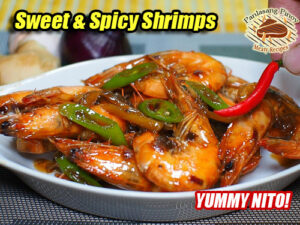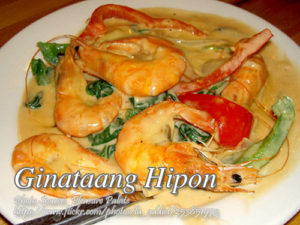Here is a popular Bicol express recipe with a twist. The crispy Bicol express. Instead of cooking the pork the usual way, which is, by boiling in water, this recipe is using cubed fried pork to make it crispy then mixed with a sauce combining coconut cream, shrimp paste and green chilies. I assure you that this is a better version of Bicol express specially those who loved eating fried foods.
You can serve this dish in two ways. One is by mixing the spicy coconut cream sauce with the fried pork or you can serve them separately, the fried pork arranged in a platter and beside it a small bowl containing the spicy coconut cream sauce.
Crispy Bicol Express: A Family Favorite with a Crispy Twist
When I think of comfort food, one dish that always makes me feel right at home is Bicol Express. But a few years back, during one of our Sunday family lunches in Cavite, my Uncle Boyet brought something different to the table. It looked like your typical Bicol Express at first glance, but when I took a bite, the pork was crispy. Not just tender with a bit of fat, but actually crunchy on the outside, juicy on the inside. It was a game-changer.
Uncle Boyet, who grew up in Albay before moving to Manila, said this “crispy Bicol Express” version was something he and his barkada experimented with during their college days. They wanted the bold flavor of the original, but with the satisfying texture of fried pork. That lunch changed the way I cook this dish at home.
Why Frying the Pork Makes a Big Difference
Traditional Bicol Express uses boiled or braised pork belly, which melts in your mouth thanks to the long simmer. But frying the pork brings a different kind of joy. When you deep-fry the pork until golden brown and crunchy, it creates a texture contrast with the creamy coconut sauce that’s just irresistible.
Plus, let’s be real — crispy anything is hard to resist. The deep-frying seals in the juices and gives each piece a flavorful crust that holds up well even after being mixed with the sauce. For beginners in the kitchen, this method is a forgiving way to create a dish that tastes like it came from a lutong-bahay pro.
The Secret Is in the Sauce
While the pork is the star, the sauce is what makes Bicol Express what it is. The creamy coconut milk mixed with shrimp paste (bagoong alamang) and siling haba brings in that distinct spicy-savory combo we Filipinos love. My cousin Jessa, who’s based in Sorsogon, swears by using native green chilies from their backyard — smaller but with a real kick.
To make the sauce, you sauté garlic and onions until soft and aromatic. Then you add the shrimp paste and let it cook just until the flavors deepen. Once the coconut cream goes in, you let it simmer until it thickens slightly. Add the green chilies and a splash of water, then season to taste. That’s it — the heart of this dish.
Two Ways to Serve Crispy Bicol Express
When I cook this at home, I like giving people options. Sometimes I serve the crispy pork already mixed with the sauce, letting it soak a little but still holding some crunch. Other times, especially during gatherings, I serve the fried pork on a platter and the spicy coconut sauce in a separate bowl. That way, everyone can dip or pour according to their taste.
This second style is actually my dad’s favorite. He says the pork stays crispy longer, and he likes spooning just enough sauce over his rice to balance each bite. It also helps if you’re feeding people with different spice tolerances — they can adjust how much sauce they want.
A Dish with Regional Roots
Bicol Express gets its name from the train route that used to run from Manila to Bicol. The dish is believed to have originated in the region, known for its love of spicy and coconut-based food. Though many versions exist today, the core idea remains: pork in a spicy coconut sauce.
Interestingly, the dish as we know it was popularized in Malate, Manila by a Bicolana cook in the 1970s. She named it after the train as a playful nod to its spicy “kick.” It’s a reminder of how Filipino dishes evolve through travel, experimentation, and memory.
Beginner-Friendly and Worth Every Step
If you’re new to cooking Filipino food, crispy Bicol Express might sound intimidating, but don’t worry — it’s more straightforward than it looks. The frying takes a bit of patience, but the rest is sauté-simmer-serve. Use pre-cut pork belly if you want to save prep time, and don’t be afraid to taste and adjust the sauce as you go.
What I love most about this recipe is how it blends the familiar and the new. It honors the traditional flavors while adding a little surprise. Every time I make it, I think of that Sunday lunch, the laughter around the table, and the way food brings everyone together.
So try this at your next family meal. Whether you mix the sauce or keep it separate, one thing’s for sure — this version will earn a spot in your regular ulams. Just be ready for people to ask for extra rice.
How To Cook Crispy Bicol Express
Ingredients
- 1/2 kilo pork belly cut into cubes
- 2 cups coconut cream
- 1 small onion chopped
- 1 head garlic minced
- 2 Tbsp. bagoong alamang or shrimp paste
- 14 pcs green long chilies or siling pangsigang stemmed and minced
- 1 Tbsp. cooking oil
- Salt and pepper to taste
- Cooking oil for deep frying
Instructions
How to Cook Crispy Bicol Express:
- Boil about 4 cups of water in a pot. Add pork, salt and pepper then simmer pork until tender.
- Then remove the pork from the boiling water and put on a colander to dry.
- Heat enough cooking oil in a pan to deep fry the pork cubes. Deep fry and drain.
- In a wide pan, heat oil over medium heat. Saute onion and garlic until fragrant.
- Add shrimp paste and stir cook until slightly brown.
- Add coconut cream, green long chilies and water then bring to a simmer.
- Season with salt and pepper. Then mix the fried pork cubes and stir until well coated.
- Serve hot with steamed rice or fried rice.
Notes
Cooking Tips:
Dry the Pork Before Frying
After boiling the pork, make sure to let it cool and dry completely before frying. Excess moisture causes the oil to splatter and prevents the pork from getting that golden, crispy crust. A few minutes in a colander or patting with paper towels makes a big difference.Use Thick Coconut Cream, Not Thin Milk
For a rich and flavorful sauce, always use kakang gata (first extract) or canned coconut cream instead of thin coconut milk. This gives the dish its signature thick, velvety texture that clings well to the pork. Thin coconut milk tends to water down the flavor and makes the sauce too runny.Add the Chilies at the Right Time
Add the green chilies once the coconut sauce starts to simmer, not too early. This keeps their heat and aroma intact without making the whole sauce overwhelmingly spicy. If you want extra spice, you can crush a few slices before adding them.





Hi Apple, thanks for dropping by and I hope you will like the dish when you cook it.
Oh I think I have a new dish becoz of this article… Thanks by the way…:)